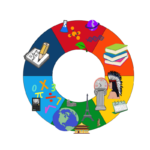DIVIDERS: Use the option of placing dividers between the desks of classmates to limit distractions and create a private work space.
learning skilLS
Sustained attention
Task Initiation
Working Memory

_________
LEARNING PREFERENCES
academic skill
Grade 6 – 9
Addition, subtraction, multiplication and division of fractions and rational numbers.

| Grade | Curriculum Focus | ||
| 5 | Add and subtract fractions with like denominators, in various contexts | ||
| 6 | Add and subtract fractions with like and unlike denominators, using appropriate tools, in various contexts | ||
| 7 | Add and subtract fractions, including by creating equivalent fractions | ||
| 8 | Multiply and divide fractions by fractions, as well as by whole numbers and mixed numbers | ||
| 9 | Solve problems involving operations with positive and negative fractions and mixed numbers | ||
Lesson Objective, Goal and Success Criteria


UDL Instruction


Differentiated Instruction

Measurement of Success

Materials, References and Resources
Supplemental Documents
Grade 5-7
Worksheets to be distributed to students– addition and subtraction of fractions
Word document
Questions and Answer to Post or Display on Board for Measurement of Success Component
| Question | Answer | |
| 1 | ¼ + ¼ | 2/4 or 1/2 |
| 2 | 7/9-1/6 | 11/18 |
| 3 | ⅝ – ⅜ | 2/8 |
| 4 | While cooking a stew, Brody used 2/5 of a shaker of salt and 1/5 of a shaker of pepper. How much more salt did Brody use? | ⅕ shakers |
| 5 | ¾ – ⅗ | 3/20 |
| 6 | 8/10 – 2/10 | 6/10 |
| 7 | When Jessica had one cat, she needed to serve 1/3 of a can of cat food each day. Now that Jessica has adopted a second cat, she needs to serve a total of 2/3 of a can each day. How much extra food is needed to feed the second cat? | ⅓ of a can |
| 8 | Mrs. Hong baked apple pies for her family. The boys ate 9/10 of a pie and the girls ate 1/10 of a pie. How much more pie did the boys eat than the girls? | 8/10 of a pie |
| 9 | 9 /10 – 1/2 | 4/10 |
| 10 | 1/9 + 2/9 + 5/9 | 8/9 |
| 11 | Each day, the polar bear at Lee’s zoo eats 1 2/5 buckets of trout and 1 2/5 buckets of salmon. How many buckets of fish does the polar bear eat daily? | 2 ⅘ buckets |
| 12 | In preparation for a picnic, Katy made a salad with 1/2 of a bag of iceberg lettuce and 1/6 of a bag of Romaine lettuce. How many bags of lettuce did Katy use in all? | 4/6 bag |
| 13 | 1/11 + 3/11 + 6/11 | 10/11 |
| 14 | 4/12 + 2/6 | 8/12 or 2/3 |
| 15 | 10 3/7 + 1 5/7 | 12 1/7 |
| 16 | Tina realizes that she had 9/10 of a box of baking powder yesterday, but the supply is now down to 7/10 of a box. How much more baking powder did Tina have yesterday? | 2/10 of a box |
| 17 | ⅚ – ¼ | 7/12 |
| 18 | Planet X is 7/10 of a light-year away from Earth. Planet Y is 2/5 of a light-year away from Earth. How much farther away is Planet X? | 3/10 light years |
| 19 | 16 4/11- 5 5/11 | 10 10/11 |
| 20 | 16 1/9 – 10 4/9 | 5 2/3 |
Grade 8
Worksheets to be distributed to students– multiplication and division of fractions
Word document
Questions and Answer to Post or Display on Board for Measurement of Success Component
| Question | Answer | |
| 1 | 15 x 1/3 | 5 |
| 2 | 2 div ⅜ | 16/3 or 5 1/3 |
| 3 | 4 ¼ x 3 ⅗ | 15 3/10 |
| 4 | 5/17 div ½ | 10/17 |
| 5 | 13 x 11/12 | 11 11/12 or |
| 6 | 3 ¾ div 3 1/3 | 15/4 div 10/3 = 45/40 |
| 7 | 4/9 div 2 | 4/18 |
| 8 | 6/7 x 8 | 6 6/7 |
| 9 | 5 ½ x 2 ⅓ | 11/2 x 7/3 = 77/6 |
| 10 | 6/13 div 3 | 6/39 |
| 11 | 3 x 3/4 | 9/4 |
| 12 | 3 div 5/18 | 54/5 |
| 13 | 130,000 x 7/15 | 60,666 2/3 |
| 14 | 18 x 5/7 | 12 6/7 or 90/7 |
| 15 | 5/18 x 2900 | 805 5/9 |
| 16 | 2 7/10 div 2 ⅖ | 27/10 div 12/5 = 135/120= 27/24 = 9/8 |
| 17 | 5 ⅔ x 5 ⅗ | 17/3 x 28/5 = 476/15 |
| 18 | 2 ¾ div1 ½ | 11/4 div 3/2= 22/12 |
| 19 | 2 div 2 1/3 | 2 div 7/3 = 6/7 |
| 20 | ⅚ div 3 ¾ | ⅚ div 15/4= 20/90 = 2/9 |
Grade 9
Worksheets to be distributed to students– multiple operations with rational numbers
Word document
Questions and Answer to Post or Display on Board for Measurement of Success Component
| Question | Answer | |
| 1 | 1/10 – 3/10 | -2/10 |
| 2 | -9/10 – (-⅗) | -9/10- (-6/10)= -3/10 |
| 3 | -9 7/10 + (-3 9/10) | -97/10 + (-39/10)= -136/10 |
| 4 | -7.7 – (-2.5) | -7.7 + 2.5 = -5.2 |
| 5 | -2 7/10 – (-6 ⅘) | -27/10 – (-34/5)= -27/10 – (-68/10)=-27 + 68 / 10 = 41/10 |
| 6 | -4 ½ + (-5 ⅗ ) | -9/2 + (-28/5) =-45/10 + (-56/10)=-101/10 |
| 7 | -8.4 – (-6.6) | -8.4 + 6.6 = -1.8 |
| 8 | ½ – (-1 ⅖) | ½ + 7/5 =5/10 + 14/10= 19/10 |
| 9 | – ⅖ x (-4/7) | -⅖ x (-4/7) = 8/3514/20 |
| 10 | -1 ⅙ x (-8 ¼) | -7/6 x (-33/4)= 231/24 |
| 11 | -4.5 x (-1.4) | 6.3 |
| 12 | -¼ div ( -⅖) | -¼ x (-5/2)= 5/8 |
| 13 | 2.7 div ( 0.5) | 5.4 |
| 14 | -3/10 div ( – ⅓) | 9/10 |
| 15 | -1 ⅔ div 2 ⅔ | 5/8 |
| 16 | -5 ⅘ – 1 | -6 ⅘ |
